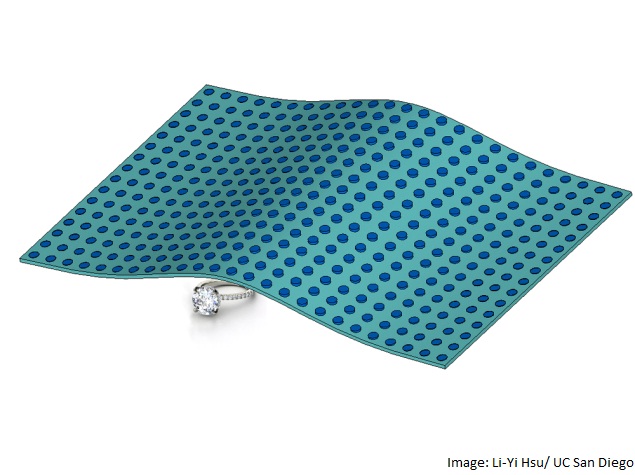- Home
- Science
- Science News
- New, Improved Invisibility Cloak Developed
New, Improved Invisibility Cloak Developed

Engineers at the University of California, San Diego designed a cloaking device that is both thin and does not alter the brightness of light around a hidden object.
The technology behind this cloak will have more applications than invisibility, such as concentrating solar energy and increasing signal speed in optical communications.
"Full invisibility still seems beyond reach today, but it might become a reality in the near future thanks to recent progress in cloaking devices," said Boubacar Kante, senior author of the study.
As their name implies, cloaks are devices that cover objects to make them appear invisible. The idea behind cloaking is to change the scattering of electromagnetic waves - such as light and radar - off an object to make it less detectable to these wave frequencies. One of the drawbacks of cloaking devices is that they are typically bulky.
"Previous cloaking studies needed many layers of materials to hide an object, the cloak ended up being much thicker than the size of the object being covered," said Li-Yi Hsu, the first author of the study. "In this study, we show that we can use a thin single-layer sheet for cloaking," said Hsu.
The researchers said that their cloak also overcomes another fundamental drawback of existing cloaking devices: being "lossy." Cloaks that are lossy reflect light at a lower intensity than what hits their surface.
"What we have achieved in this study is a 'lossless' cloak. It won't lose any intensity of the light that it reflects," said Kante.
Many cloaks are lossy because they are made with metal particles, which absorb light. The researchers report that one of the keys to their cloak's design is the use of non-conductive materials called dielectrics, which unlike metals do not absorb light.
The cloak includes two dielectrics, a proprietary ceramic and Teflon, which are structurally tailored on a very fine scale to change the way light waves reflect off of the cloak.
In their experiments, the researchers specifically designed a "carpet" cloak, which works by cloaking an object sitting on top of a flat surface. The cloak makes the whole system - object and surface - appear flat by mimicking the reflection of light off the flat surface.
Any object reflects light differently from a flat surface, but when the object is covered by the cloak, light from different points is reflected out of sync, effectively cancelling the overall distortion of light caused by the object's shape.
"This cloaking device basically fools the observer into thinking that there's a flat surface," said Kante.
The study was published in the journal Progress In Electromagnetics Research.
Catch the latest from the Consumer Electronics Show on Gadgets 360, at our CES 2026 hub.
- Samsung Galaxy Unpacked 2025
- ChatGPT
- Redmi Note 14 Pro+
- iPhone 16
- Apple Vision Pro
- Oneplus 12
- OnePlus Nord CE 3 Lite 5G
- iPhone 13
- Xiaomi 14 Pro
- Oppo Find N3
- Tecno Spark Go (2023)
- Realme V30
- Best Phones Under 25000
- Samsung Galaxy S24 Series
- Cryptocurrency
- iQoo 12
- Samsung Galaxy S24 Ultra
- Giottus
- Samsung Galaxy Z Flip 5
- Apple 'Scary Fast'
- Housefull 5
- GoPro Hero 12 Black Review
- Invincible Season 2
- JioGlass
- HD Ready TV
- Laptop Under 50000
- Smartwatch Under 10000
- Latest Mobile Phones
- Compare Phones
- Honor Magic 8 RSR Porsche Design
- Honor Magic 8 Pro Air
- Infinix Note Edge
- Lava Blaze Duo 3
- Tecno Spark Go 3
- iQOO Z11 Turbo
- OPPO A6c
- Samsung Galaxy A07 5G
- Lenovo Yoga Slim 7x (2025)
- Lenovo Yoga Slim 7a
- Lenovo Idea Tab Plus
- Realme Pad 3
- Moto Watch
- Garmin Quatix 8 Pro
- Haier H5E Series
- Acerpure Nitro Z Series 100-inch QLED TV
- Asus ROG Ally
- Nintendo Switch Lite
- Haier 1.6 Ton 5 Star Inverter Split AC (HSU19G-MZAID5BN-INV)
- Haier 1.6 Ton 5 Star Inverter Split AC (HSU19G-MZAIM5BN-INV)


![[Sponsored] Haier C90 OLED TV | Dolby Vision IQ, 144Hz OLED and Google TV in Action](https://www.gadgets360.com/static/mobile/images/spacer.png)









